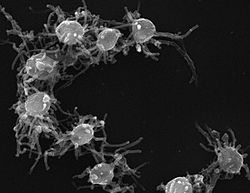| Filasterea | |
|---|---|
 | |
| Capsaspora owczarzaki | |
| Scientific classification | |
| Domain: | Eukaryota |
| Clade: | Amorphea |
| Clade: | Obazoa |
| Clade: | Opisthokonta |
| Clade: | Holozoa |
| Clade: | Filozoa |
| Class: | Filasterea Salchian-Tabrizi, 2008 |
| Families and genera | |
Filasterea is a basal Filozoan clade of single-celled ameboid eukaryotes that includes Ministeria and Capsaspora . [1] It is a sister clade to the Choanozoa in which the Choanoflagellatea and Animals appeared, originally proposed by Shalchian-Tabrizi et al. in 2008, based on a phylogenomic analysis with 78 genes. Filasterea was found to be the sister-group to the clade composed of Metazoa and Choanoflagellata within the Opisthokonta, a finding that has been further corroborated with additional, more taxon-rich, phylogenetic analyses. [2] [3] [4]

